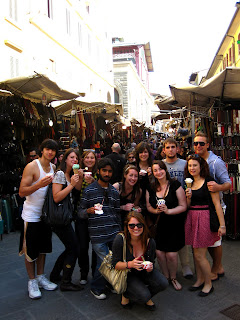
There are various types of research associated with studying abroad, and none surpass the importance of food research. It’s an art form and takes someone with cultured taste to be able to critique the best of the best foreign meals. That being said, the European Odyssey group was given the burden of taste-testing gelato throughout its home in Italy. It was a tough job, but someone had to do it. We slaved away, walking from gelateria to gelateria in search of the best gelato. There were many taste-testing spoon casualties all for the sake of satisfying the all-powerful sweet tooth. From the Cinque Terre to Florence, to Rome and finally Sorrento…no gelato was safe. Some of us stuck to the same gelato formula, hardly veering off into new flavors. Others got a bit adventurous, and one of our peers, Sarah Santos, became Gelato MVP by tasting a total of 16 flavors.
What is the difference between gelato and ice cream you may ask? We pondered the same question. Well in Rome we got our answer. At Teatro Gelateria, one of the owners told us the process of making gelato. Although it was hard to concentrate with all of the flavors staring at us from behind the sloped glass cooler, we found out some of the major differences between the icy treats. Gelato comes from the Italian word gelare, which means “to freeze” and is made of milk, sugar and other flavors (much like its sister, ice cream). There is however a water-based, generally fruit-flavored gelato which originated in Southern Italy and is commonly known as sorbetto. Gelato is often much fresher than ice cream, both in processing and in ingredients. Gelato is usually made with fresh fruit, right from the daily market. We learned that a flavor is natural and authentic if it has coloring that is natural to the actual ingredient the gelato is flavored after. For instance, banana gelato shouldn’t be colored bright yellow because the actual fruit is more of an off-white hue. Gelato made with dairy is much denser than ice cream, which makes it a heavier as well as more flavorful taste.
One of my favorite gelaterias was in Florence. Each night we would walk down our street to the same place, Gelateria Antica, which made fresh, homemade gelato. It was run by two of the nicest Italian men who gave us unlimited tastes and would talk to us and take pictures with us the entire time we were there. They had some normal, run-of-the-mill gelatos like Nutella (a delicious classic), After Eight (Mint Chocolate), Pure Chocolate, Vanilla, Stracciatella (Vanilla with Chocolate Flakes), and Coconut. But they also had unique flavors like “Manga” (Green Tea), Cheese and Pear, Tiramisu, and Ambrosia (Sweet Cream/Honey). It’s really hard to choose a favorite gelateria, but that one came close to the top.
Gelato was no match for the European Odyssey team.



































